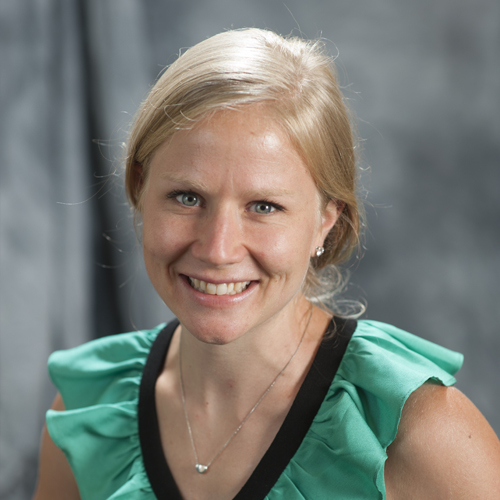Cameron Varano named first author on collaborative and translational paper
October 30, 2015

Cameron Varano, a doctoral student in the Translational Biology, Medicine, and Health program, was first author on a recently published paper in the journal Chemical Communications. The paper includes three principal investigators – Deborah Kelly, Sarah McDonald, and Steven Poelzing, all from the Virginia Tech Carilion Research Institute.
The researchers used a model virus system to produce the first time-resolved videos of individual biological complexes moving in solution within an electron microscope.
“There remains a critical need to develop real-time imaging resources for life sciences,” said Varano, who is in her second year of the graduate program. “In this paper, we demonstrated the use of high-resolution in situ imaging to observe biological complexes in liquid at the nanoscale.”
In most high-resolution imaging, biological complexes – including viral invasions – are frozen to prevent movement that may blur the images.
“Life is dynamic,” Varano said. “Visualizing and analyzing biological samples in real-time gives us a much more compelling view into the complexities of life.”
For this study, researchers tethered rotavirus particles to a microchip filled with solution. The particles were able to move naturally, and the scientists could snap still images quickly of the virus particles. After the images were procured, the researchers created movies of the images and corrected for time placement. The result was moving virus particles, behaving naturally, that the scientists could observe in high-resolution.
“The next step is to improve the resolution further, and to increase the number of frames we take per second,” Varano said. “Each goal is one step closer to true, real-time imaging.”
Varano was also named as an author on another paper published in the Journal of Analytical and Molecular Techniques earlier this year. In that study, researchers examined the interactions between viral proteins and genetic material in rotavirus. Their work is an important stepping-stone in understanding viral dynamics as the virus enters and engages with a host’s immune system.
“It’s amazing that we, as complex life forms, are made of such small components,” Varano said. “And it’s so exciting to see life in this tiny, intricate way. It makes the larger scale of life seem even more impressive.”
Varano currently works in the laboratory of her mentor, Deborah Kelly. Kelly is lead author of both papers and an assistant professor at the Virginia Tech Carilion Research Institute.
“Cameron’s productivity as a new scholar at Virginia Tech is outstanding,” Kelly said. She also noted the work Varano is contributing to has the high potential to reveal active molecular mechanisms for the first time. “This research is truly a new frontier, and I look forward to continuing along this exciting trajectory with Cameron.”
Cameron Varano, a doctoral student in the Translational Biology, Medicine, and Health program, was first author on a recently published paper in the journal Chemical Communications. The paper includes three principal investigators – Deborah Kelly, Sarah McDonald, and Steven Poelzing, all from the Virginia Tech Carilion Research Institute.
The researchers used a model virus system to produce the first time-resolved videos of individual biological complexes moving in solution within an electron microscope.
“There remains a critical need to develop real-time imaging resources for life sciences,” said Varano, who is in her second year of the graduate program. “In this paper, we demonstrated the use of high-resolution in situ imaging to observe biological complexes in liquid at the nanoscale.”
In most high-resolution imaging, biological complexes – including viral invasions – are frozen to prevent movement that may blur the images.
“Life is dynamic,” Varano said. “Visualizing and analyzing biological samples in real-time gives us a much more compelling view into the complexities of life.”
For this study, researchers tethered rotavirus particles to a microchip filled with solution. The particles were able to move naturally, and the scientists could snap still images quickly of the virus particles. After the images were procured, the researchers created movies of the images and corrected for time placement. The result was moving virus particles, behaving naturally, that the scientists could observe in high-resolution.
“The next step is to improve the resolution further, and to increase the number of frames we take per second,” Varano said. “Each goal is one step closer to true, real-time imaging.”
Varano was also named as an author on another paper published in the Journal of Analytical and Molecular Techniques earlier this year. In that study, researchers examined the interactions between viral proteins and genetic material in rotavirus. Their work is an important stepping-stone in understanding viral dynamics as the virus enters and engages with a host’s immune system.
“It’s amazing that we, as complex life forms, are made of such small components,” Varano said. “And it’s so exciting to see life in this tiny, intricate way. It makes the larger scale of life seem even more impressive.”
Varano currently works in the laboratory of her mentor, Deborah Kelly. Kelly is lead author of both papers and an assistant professor at the Virginia Tech Carilion Research Institute.
“Cameron’s productivity as a new scholar at Virginia Tech is outstanding,” Kelly said. She also noted the work Varano is contributing to has the high potential to reveal active molecular mechanisms for the first time. “This research is truly a new frontier, and I look forward to continuing along this exciting trajectory with Cameron.”


